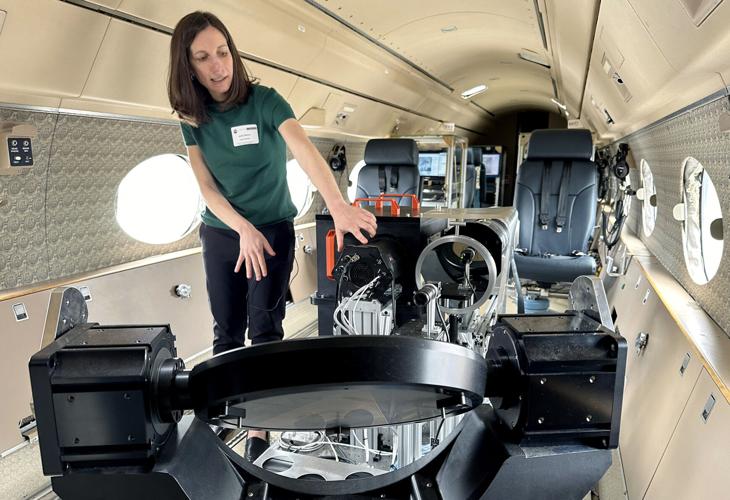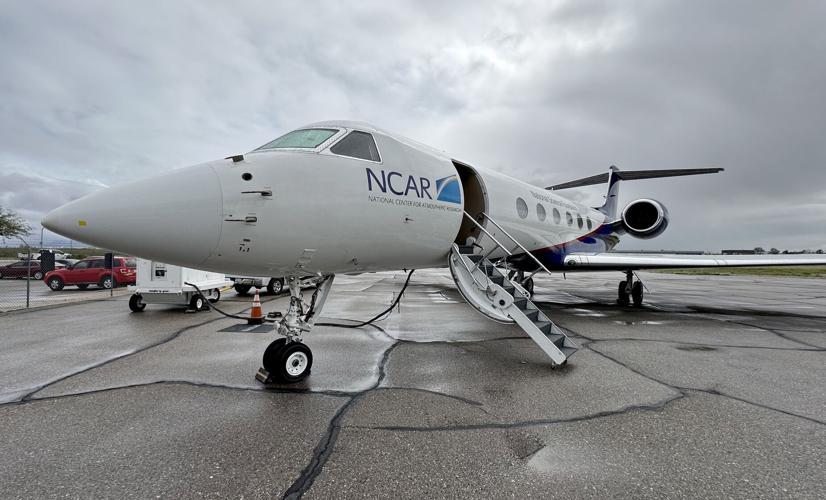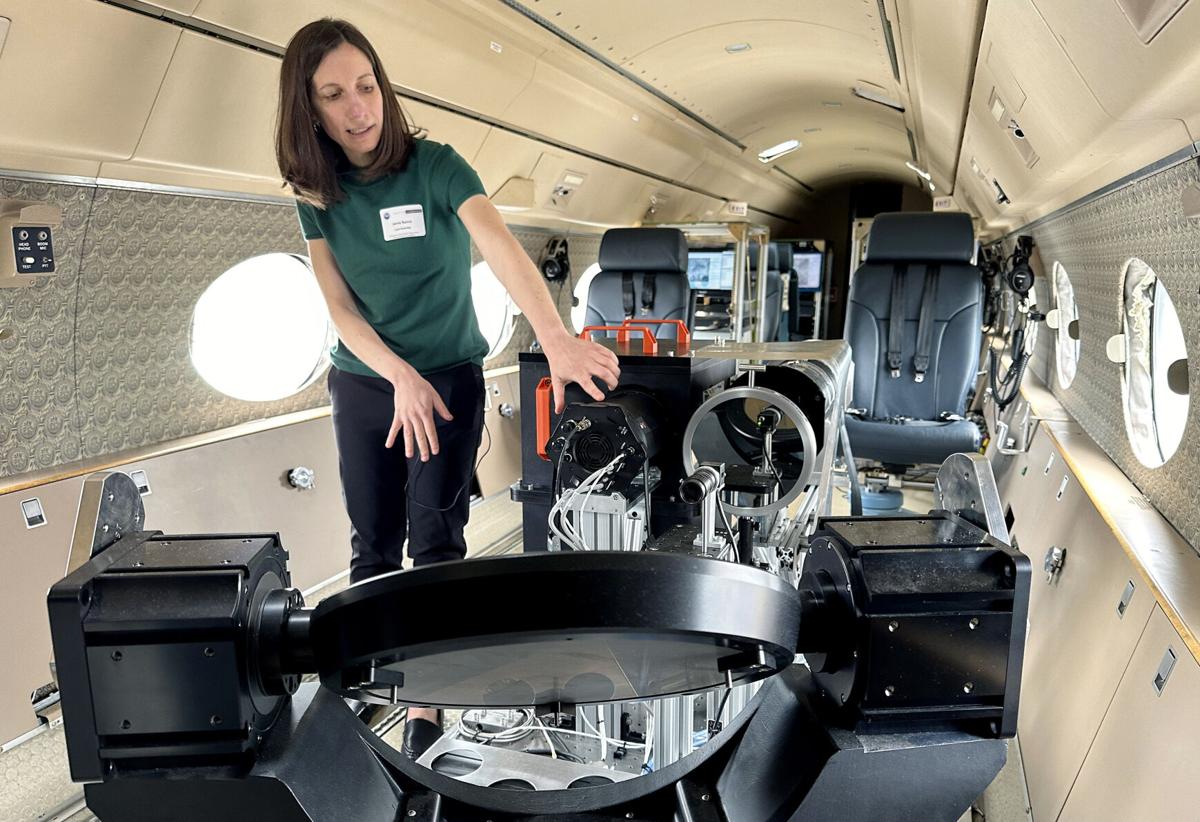More than 1 million tourists are expected to gather along the path of Monday’s total solar eclipse, but Jenna Samra will have one of the best seats in the house.
That morning, the astrophysicist will fly from Tucson to Texas on board a Gulfstream V jet loaded with scientific equipment to chase the moon’s shadow from a vantage point high above the clouds.
Too bad she won’t get to see much of the celestial show. Samra will be too busy leading what she called “a mission of opportunity” to study the solar corona while the rest of the sun is blocked by the moon.
“We’ve got a lot riding on six minutes,” she said.
That’s how long the total eclipse is expected to last for the eight crew members on board the aircraft, which is operated by the National Science Foundation’s National Center for Atmospheric Research or NCAR.
If everything goes according to plan, the Gulfstream will arrive over Texas about 45 minutes before the shadow of the moon does. Then, Samra said, “we will get on the track (of totality) and let the eclipse run us over.”
Bo LeMay, chief pilot for NCAR, said they will be flying in the same direction as the eclipse at about 500 mph, which will give them roughly two more minutes of totality than what people on the ground will experience.

A specially equipped Gulfstream V operated by the National Science Foundation’s National Center for Atmospheric Research is parked at Million Air hangar at Tucson International Airport on Monday. The aircraft will chase the April 8 solar eclipse through Texas to collect data on the sun’s outer atmosphere.
The aircraft would need to be traveling at roughly 1,500 mph — more than twice the speed of sound, far faster than a Gulfstream V can go — to keep pace with the moon’s shadow.
“If they can get us a Concorde, I’d be happy to get checked out on it,” LeMay said with a smile.
Tucson departure
NCAR’s flying research platform is based in Broomfield, Colorado, north of Denver, but team members chose the Million Air hangar at Tucson International Airport as their base of operations for Monday’s flight because they originally planned to catch the eclipse as it passes over Mexico.
That idea was scrapped because they couldn’t be sure Mexican aviation officials would grant them permission to fly there.
Instead, the team will intercept the moon’s shadow between San Antonio and Dallas.
They will use their six minutes of totality to commission a new piece of scientific equipment called ACES, which is short for Airborne Coronal Emission Surveyor.
Samra said the best time to observe the sun’s outer atmosphere is when the moon is covering the rest of it, since the corona is about a million times dimmer than the blinding photosphere it surrounds.
She and her team spent the past two and a half years building their telescope and spectrometer at the Harvard and Smithsonian Center for Astrophysics in Cambridge, Massachusetts.
The purpose of ACES — and Monday’s flight — is to study the infrared light emitted by the corona in hopes of figuring out a way to measure the elusive and volatile magnetic field surrounding the sun.
“It’s a pathfinder for future instruments,” Samra said.
The sun’s magnetic field stores enough energy to heat the corona to more than 1 million degrees Fahrenheit.
A better understanding of the field could one day allow scientists to forecast “space weather events” such as solar flares that can damage Earth’s orbiting satellites and ground-based electronics, including the electrical grid, said ACES scientist Chad Madsen.
“The more we know, the better we can predict specific structures” that can lead to solar storms, he said.
They will make their observations on Monday from an altitude of about 47,000 feet, high enough to avoid any clouds and most of the infrared-absorbing water vapor found lower in Earth’s atmosphere.
To collect the data they need, the aircraft must be oriented so the eclipse-dimmed light from the sun shines down onto ACES through an expensive, 9-inch window in the roof of the fuselage made from two panes of pure sapphire that were fabricated in a lab.
“Regular airplane glass would actually block a lot of the infrared light we’re looking for,” Madsen explained.
Samra said ACES is equipped with an electronically controlled mirror that can make up to 1,000 movements a second to compensate for the movement of the aircraft and keep the light from the corona directed into the telescope.
“You can’t see it, because the movements are so small, but they’re very important,” she said.
Practice time
The team tested the ACES system during three practice flights over Colorado before arriving in Tucson late last week.
To make sure they are ready for Monday, Samra said they would be conducting two full dress rehearsals this week in the sky over Texas, where they will make “the exact run at the exact time” they will be doing it on April 8.
“There’s a lot of precision involved in being in the right place at the right time,” Madsen added.
If previous eclipses are any indication, the researchers won’t be the only ones chasing totality above the clouds on Monday.
During the 2017 eclipse that crossed the U.S. from Oregon to South Carolina, LeMay said, they had to abort their science flight sooner than expected over Chattanooga, Tennessee, to avoid a rented Learjet that strayed into the path of the research plane.
“Everybody was trying to see the eclipse,” Samra said.
Luckily, they were able to collect all the data they needed before their unexpected flight deviation.
Monday’s eclipse will be the third Samra has experienced from NCAR’s research aircraft, though she has never gotten to really soak one in the way casual spectators get to.
“I think I’ve only seen about three seconds of a total eclipse so far,” she said with a laugh.
Two years after her 2017 flight, she was back on the Gulfstream as it chased the moon’s shadow across the South Pacific, then landed on Rapa Nui, also known as Easter Island.
The ACES team hopes to build on Monday’s mission by flying their instrument through another total eclipse in 2026, this one over the North Atlantic near Iceland.
There’s simply no better time to study the outer reaches of the sun.
“It’s such a unique opportunity,” Samra said. “You’re bound to learn something.”






